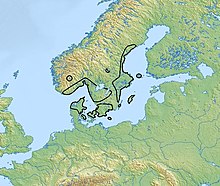Dimple ceramic culture
The pit ceramic culture (GKK - ( Danish Grubekeramisk culture ; Swedish Gropkeramiska cultures ; English pitted ware culture ), also called " pit pottery ", sometimes equated with the comb ceramic culture ( English Comb Ceramic culture )) was an archaeological culture of the 4th and 3rd centuries . Millennium BC In Denmark , southern Scandinavia and northern eastern Europe . Although at this time the rural way of life of the Neolithic had already found its way into its area of distribution , the Mesolithic tradition of hunters and gatherers lived on in the dimpled ceramic culture . It owes its name to the characteristic decorations of its pointed or flat-bottomed ceramics . In the final phase there is also beaded ceramics .
description
The distribution area of the GKK extended in northern Europe from southern Norway over the northern coastal regions and islands of the Baltic Sea (northern Denmark , Gotland , Åland ), in Sweden , over the Baltic States ( lagoon culture ) to the central Dnepr and Don area , probably in the east to over out the Urals.
In time, it runs roughly parallel to the funnel cup culture and cord ceramics .
Mesolithic traditions survived here at least until the 3rd millennium BC. The first pit ceramic settlement was discovered in 1864 in Visby on Gotland. With Gullrum, Hemmoor and Stora Karlsö , around 20 other places are known that can be dated by the four meters of land that was raised during the period of the culture . On the Swedish mainland, more than 60 dwellings are now known to culture ( Alvastra stilt houses ).
The people were hunters and gatherers , as so far only bones of wild animals have been found. These mainly belonged to bears , beavers , moose , rabbits , wild boars and birds. Near the coast or on fish-rich freshwater aquatic flora as hunting, what with found outweighed seal bones , fish hooks , harpoons is recognizable and impressions of networks. Isotope studies in the Västerbjers cemetery on Gotland also confirm this. Pig bones are known from Gotland, which could have come from domestic pigs, as the wild boar was not native to the island at that time.
The skeleton of a boy found in Ire on Gotland was given fish hooks, a flint ax, a harpoon, a broken bone slice, a knife from a boar's tusk, and tubular beads. The culture bearers of the mainland took over the stone grinding from the neighboring farming cultures. Finds from Swedish living quarters include axes made of flint and rock, fish spears and harpoons made of bones, and arrowheads made of flint and slate .
Forest Neolithic
In the forest zone of Northeast Europe existed from the 6th to the 2nd millennium BC. A cultural complex called “Neolithic”, which is characterized by a specific ceramics decorated with combs and pits (burial grounds Olenij ostrov (Karelia) and Beregovaya near Yekaterinburg ). It differs from the central and southern European Neolithic at the same time in that, despite the appearance of ceramics, a mesolithic, appropriate economic method formed the basis of life. Local stability can also only be assumed to a limited extent; rather, seasonal migrations may have predominated. Of decisive importance is the question of whether the impetus for this development came from the fully Neolithic cultures, or whether the ceramics-producing hunters of north-eastern Europe represent a tradition that is completely independent of this. From 5000 BC Stations occurring up to the 2nd millennium form a bridge to the North Scandinavian "slate culture " . On the Kola Peninsula , around the turn of the century, the development shifted to the living quarters of the Saami , who later ran reindeer herding . Large parts of this culture go back to around 4300 BC. Chr. Successively in the funnel beaker culture (TBK) and its subsequent cultures.
Locations
literature
- Carl Johan Becker : The Middle Neolithic Cultures in Southern Scandinavia. In: Acta Archaeologica . Vol. 25, 1954, ISSN 0065-101X , pp. 49-150.
- Torsten Madsen: The Neolithic Age in Southern Scandinavia. In: Joachim Preuß (Ed.): The Neolithic in Central Europe. Cultures - Economy - Environment. From the 6th to the 3rd millennium BC, overviews of the state of research. Volume 1, Part 2 B: Overviews of the status and problems of archaeological research. Beier and Beran, Weissbach 1998, ISBN 3-930036-10-X , pp. 423-450.
- Marek Zvelebil , Robin Dennell , Lucyna Domanska (eds.): Harvesting the Sea, Farming the Forest. The Emergence of Neolithic Societies in the Baltic Region (= Sheffield Archaeological Monographs. Vol. 10). Sheffield Academic Press, Sheffield 1998, ISBN 1-85075-648-1 .
Individual evidence
- ↑ Gunilla Eriksson: Part-time farmers or hard-core sealers? Västerbjers studied by means of stable isotope analysis. In: Journal of Anthropological Archeology. Vol. 23, No. 2, 2004, ISSN 0278-4165 , pp. 135-162.
- ↑ John Lepiksaar: The Holocene History of Theriofauna in Fennoscandia and Baltic Countries. In: Lars-König Königsson (Ed.): Nordic Late Quaternary Biology and Ecology (= Striae. Vol. 24). Societas upsaliensis pro geologia quaternaria, Uppsala 1986, ISBN 91-7388-051-5 , pp. 51-70.


